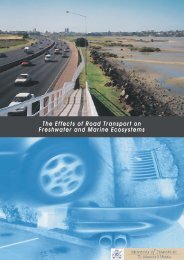Motor Vehicle Crashes in New Zealand 2011 - Ministry of Transport
Motor Vehicle Crashes in New Zealand 2011 - Ministry of Transport
Motor Vehicle Crashes in New Zealand 2011 - Ministry of Transport
Create successful ePaper yourself
Turn your PDF publications into a flip-book with our unique Google optimized e-Paper software.
118<br />
<strong>Motor</strong> <strong>Vehicle</strong> <strong>Crashes</strong> <strong>in</strong> <strong>New</strong> <strong>Zealand</strong> <strong>2011</strong><br />
notes<br />
1. Data<br />
The data <strong>in</strong> this section <strong>in</strong>cludes alcohol <strong>of</strong>fences<br />
recorded by police. There can be several alcohol<br />
<strong>of</strong>fence codes related to a s<strong>in</strong>gle <strong>in</strong>cident. For the<br />
follow<strong>in</strong>g tables and graphs, ‘<strong>of</strong>fenders’ are counted<br />
only once for each <strong>in</strong>cident. Any <strong>of</strong>fence records for the<br />
same <strong>in</strong>dividual that occur with<strong>in</strong> the same hour are<br />
treated as a s<strong>in</strong>gle <strong>in</strong>cident. Not all the <strong>of</strong>fences reported<br />
here will result <strong>in</strong> a successful prosecution.<br />
2. Limits and test<strong>in</strong>g procedure<br />
As from December 1988 the legal breath alcohol level<br />
was lowered from 500 micrograms <strong>of</strong> alcohol per litre <strong>of</strong><br />
breath to 400 micrograms <strong>of</strong> alcohol per litre <strong>of</strong> breath.<br />
From 1 April 1993, for those aged under 20 years, the<br />
legal breath alcohol limit was lowered to 150<br />
micrograms <strong>of</strong> alcohol per litre <strong>of</strong> breath and the legal<br />
blood alcohol level was reduced to 30mg <strong>of</strong> alcohol per<br />
100ml <strong>of</strong> blood.<br />
From 7 August <strong>2011</strong> the legal breath and blood alcohol<br />
limits, for drivers under 20 years, have been lowered to<br />
zero.<br />
The procedure is:<br />
i. A breath screen<strong>in</strong>g test is requested.<br />
ii. If the screen<strong>in</strong>g test is positive or not taken for any<br />
reason, the driver is asked to accompany the <strong>of</strong>ficer to a<br />
place where an evidential breath or blood test may be<br />
taken.<br />
iii. If the evidential breath test:<br />
(a) is not taken for any reason, then a blood sample is<br />
requested by the <strong>of</strong>ficer.<br />
(b) gives a read<strong>in</strong>g <strong>of</strong> not over 400 micrograms <strong>of</strong><br />
alcohol per litre <strong>of</strong> breath (above zero for those<br />
under 20 years), then the test is considered negative<br />
and no blood sample is requested.<br />
(c) gives a read<strong>in</strong>g <strong>of</strong> over 400 (zero for those under 20<br />
years), then the driver, after be<strong>in</strong>g advised <strong>of</strong><br />
his/her rights, decides whether to accept the<br />
read<strong>in</strong>g and subsequent court action or to request a<br />
blood sample.<br />
Refus<strong>in</strong>g a blood sample when requested by an <strong>of</strong>ficer, or a<br />
result over the legal limit, normally results <strong>in</strong> court charges.

















